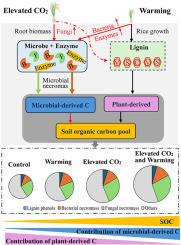当前位置:
X-MOL 学术
›
Soil Biol. Biochem.
›
论文详情
Our official English website, www.x-mol.net, welcomes your
feedback! (Note: you will need to create a separate account there.)
Contributions of microbial necromass and plant lignin to soil organic carbon stock in a paddy field under simulated conditions of long-term elevated CO2 and warming
Soil Biology and Biochemistry ( IF 9.8 ) Pub Date : 2024-11-19 , DOI: 10.1016/j.soilbio.2024.109649 Yuan Liu, Weijie Li, Hongfan Meng, Qinyu Xu, Liqiang Sun, Long Zhang, Qingsong Ba, Xiaoyu Liu, Cheng Liu, Li Jiang
Soil Biology and Biochemistry ( IF 9.8 ) Pub Date : 2024-11-19 , DOI: 10.1016/j.soilbio.2024.109649 Yuan Liu, Weijie Li, Hongfan Meng, Qinyu Xu, Liqiang Sun, Long Zhang, Qingsong Ba, Xiaoyu Liu, Cheng Liu, Li Jiang

|
Global climate change has various fundamental impacts on plant productivity and soil microbial communities, altering the formation and sequestration of soil organic carbon (SOC). However, the effect of climate change on different SOC components such as plant- derived C and microbial-derived C, remains poorly understood. A 3-year field experiment was conducted from 2018-2020 to examine the impacts of elevating atmospheric CO2 levels (550 ppm) and warming (+2°C) on microbial necromass, plant lignin and phospholipid fatty acid (PLFA) in a Chinese rice paddy. Results showed that elevated CO2 and warming conditions increased the SOC stock by 16.5% and 8.6%, respectively. Elevated CO2 increased the accumulation of microbial necromass (mainly fungal) C by 24.6% and total lignin phenols by 15.8%, while also increasing the biomass of fungal PLFAs by 33.4%. In comparison, warming increased the accumulation of microbial necromass C (mainly bacterial necromass) by 11.1% and bacterial biomass by 27.1%, while it decreased total lignin phenols and their contribution to SOC by 8.3% and 15.7%, respectively. The reduction in lignin phenols and their contribution to SOC under warming conditions was mainly attributed to the lower level of plant productivity and increased activities of the enzymes β-1,4-glucosidase, β-cellobiohydrolase and xylanase. This resulted in increased plant residue conversion to microbial necromass in warmed soils. Random forest and correlation analysis indicated that soil pH, fungal biomass, root biomass and C-acquiring enzyme activities were the major factors affecting microbial necromass, while lignin phenols were mainly regulated by the ratio of fungal/bacterial necromass and fungal biomass. Overall, the combined effects of CO2 enrichment and warming conditions increased the storage and sequestration of SOC by enhancing the accumulation of microbial necromass, which was affected by soil properties, plant root C inputs and microbial communities within soil.
更新日期:2024-11-19


















































 京公网安备 11010802027423号
京公网安备 11010802027423号